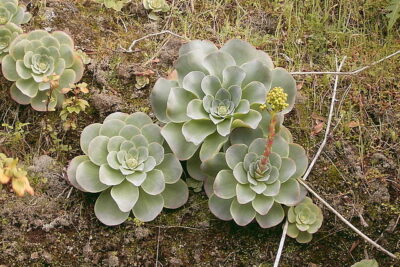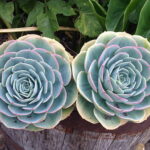
Indoor or Outdoor: Choosing the Right Environment for Your Succulents

Succulents are a popular choice for plant enthusiasts due to their unique and striking appearance. These plants are known for their ability to store water in their leaves, stems, and roots, making them highly adaptable to various environments. However, when it comes to deciding whether to keep your succulents indoors or outdoors, there are several factors to consider.
We will explore the pros and cons of keeping succulents in both indoor and outdoor environments. We will discuss the different lighting, temperature, and humidity requirements that succulents have, as well as the benefits and challenges of each setting. Additionally, we will provide tips and recommendations on how to successfully care for your succulents in both indoor and outdoor settings, ensuring that they thrive and bring beauty to your space.
- Consider the lighting conditions of your home or outdoor space
- Determine the temperature and humidity levels that your succulents prefer
- Evaluate the available space and size of your succulent collection
- Assess your ability to control environmental factors such as watering and airflow
- Research the specific care requirements of your succulents
- Seek advice from experienced succulent growers or horticulturists
- Experiment with both indoor and outdoor environments to see what works best
- Frequently Asked Questions
Consider the lighting conditions of your home or outdoor space
When choosing the right environment for your succulents, it's important to consider the lighting conditions of your home or outdoor space. Succulents thrive in bright light, so it's essential to provide them with the right amount of sunlight to ensure their healthy growth.
If you plan on keeping your succulents indoors, place them near a south-facing window where they can receive at least six hours of sunlight per day. This will mimic the natural conditions they would experience in their native habitats.
However, if your home doesn't have access to sufficient natural light, you can also supplement it with artificial grow lights. LED grow lights are a popular choice as they provide the necessary light spectrum for succulents without producing excessive heat.
Consider the temperature and humidity levels
In addition to lighting conditions, it's crucial to consider the temperature and humidity levels of your chosen environment. Succulents are known for their ability to tolerate dry conditions, but they also require some level of humidity to thrive.
Indoor environments often have lower humidity levels, especially during winter when heating systems are in use. To increase humidity, you can place a tray filled with water near your succulents or use a humidifier in the room.
 Can Succulents Survive Outdoors Year-Round?
Can Succulents Survive Outdoors Year-Round?On the other hand, if you plan on keeping your succulents outdoors, ensure that the climate in your area is suitable for their needs. Succulents generally prefer warm and dry climates, although some varieties can tolerate colder temperatures.
Consider the size and type of your succulents
The size and type of your succulents should also influence your decision on whether to keep them indoors or outdoors. Some succulents can grow quite large and may not be suitable for indoor spaces with limited room for expansion.
If you have smaller succulents, they can be easily accommodated indoors in small pots or terrariums. This allows you to create a mini succulent garden that can be placed on a desk, shelf, or windowsill.
Alternatively, if you have larger succulents or plan on growing them in the ground, an outdoor environment would be more suitable. This will provide ample space for their growth and allow them to reach their full potential.
Remember to consider the specific care requirements of each succulent species as they may have varying preferences for light, temperature, and humidity. By understanding their needs and choosing the right environment, you can ensure the health and longevity of your succulents.
Determine the temperature and humidity levels that your succulents prefer
When it comes to caring for your succulents, one of the most important factors to consider is the environment in which they will thrive. Different succulent varieties have different temperature and humidity preferences, so it's crucial to determine the conditions that best suit your plants.
Temperature
Most succulents are native to arid regions and are adapted to thrive in warm climates. However, the ideal temperature range can vary depending on the specific species. Generally, succulents prefer temperatures between 60°F (15°C) and 80°F (27°C). It's important to avoid extreme temperature fluctuations, as this can stress your plants and affect their growth.
 Indoor Succulent Care: Expert Tips for Blue Succulents
Indoor Succulent Care: Expert Tips for Blue SucculentsIf you live in a region with cold winters, it's best to bring your outdoor succulents indoors or provide them with some form of winter protection. On the other hand, if you live in a hot and humid climate, you may need to provide extra shade or protection from intense sunlight to prevent sunburn.
Humidity
Succulents are known for their ability to tolerate dry conditions, which is why they make great indoor plants. However, some succulents do prefer slightly higher humidity levels than others. As a general rule, most succulents thrive in environments with relative humidity levels between 30% and 50%. If the air in your home is too dry, you can increase humidity by placing a tray of water near your plants or using a humidifier.
It's important to note that while succulents can tolerate higher humidity levels, they are still susceptible to root rot if their soil remains constantly wet. Therefore, it's crucial to ensure that your succulents are planted in well-draining soil and that you water them sparingly.
By understanding the temperature and humidity preferences of your succulents, you can create the ideal environment for them to thrive. Whether you choose to keep them indoors or outdoors, providing the right conditions will ensure that your succulents remain healthy and beautiful.
Evaluate the available space and size of your succulent collection
When deciding whether to keep your succulents indoors or outdoors, it is important to first evaluate the available space and the size of your succulent collection. This will help you determine whether indoor or outdoor environments are more suitable for your plants.
If you have a small succulent collection and limited space, keeping them indoors might be the best option. Indoor environments provide controlled conditions, allowing you to closely monitor factors such as temperature, light, and humidity. This is especially important if you live in an area with extreme weather conditions or if you prefer to have your succulents in a specific room or area of your home.
On the other hand, if you have a large succulent collection or ample outdoor space, you may consider keeping your succulents outdoors. Succulents thrive in natural sunlight and fresh air, and outdoor environments can provide them with the ideal conditions for growth. Additionally, outdoor spaces often allow succulents to spread out and grow freely, giving them the opportunity to reach their full potential.
 Indoor or Outdoor: Maximizing Succulent Growth for Optimal Results
Indoor or Outdoor: Maximizing Succulent Growth for Optimal ResultsConsider the lighting conditions
Lighting is a crucial factor to consider when deciding between indoor and outdoor environments for your succulents. Succulents generally require bright, indirect light to thrive. If you have a well-lit indoor space that receives plenty of natural light throughout the day, your succulents can do well indoors.
However, if your indoor space lacks adequate natural light, or if you live in a region with limited sunlight, your succulents may struggle to receive the necessary light they need to maintain their health and vibrant colors. In such cases, placing your succulents outdoors where they can receive direct sunlight for several hours a day is highly recommended.
Take into account temperature and climate
Temperature and climate are other important factors to consider when choosing the right environment for your succulents. Succulents are known for their ability to tolerate a wide range of temperatures, but extremes can be detrimental to their health.
If you live in an area with harsh winters or extremely hot summers, it might be best to keep your succulents indoors where you can control the temperature and provide them with adequate protection. On the other hand, if you live in a mild climate with moderate temperature fluctuations, your succulents can thrive outdoors and benefit from the natural climate conditions.
Assess the level of care and maintenance
The level of care and maintenance required for your succulents can also play a role in determining whether to keep them indoors or outdoors. Indoor succulents generally require more frequent watering and monitoring, as indoor environments tend to have lower humidity levels.
Outdoor succulents, on the other hand, are exposed to natural rainfall and can often rely on the environment to provide them with the necessary moisture. This can reduce the frequency of watering and make outdoor succulents easier to maintain.
Ultimately, the decision to keep your succulents indoors or outdoors depends on several factors, including space availability, lighting conditions, temperature and climate, as well as the level of care and maintenance you are willing to provide. By considering these factors, you can choose the right environment for your succulents and ensure their optimal growth and overall well-being.
 Growing Curly Jade Succulents Indoors: Tips and Advice
Growing Curly Jade Succulents Indoors: Tips and AdviceAssess your ability to control environmental factors such as watering and airflow
When it comes to deciding whether to keep your succulents indoors or outdoors, one of the crucial aspects to consider is your ability to control environmental factors. Succulents thrive in specific conditions, and by carefully managing these factors, you can ensure the health and vitality of your plants.
1. Watering: Succulents are known for their ability to store water in their leaves and stems, making them well-suited for arid environments. However, they still require regular watering, albeit in smaller quantities compared to other plants. Indoor succulents benefit from controlled watering since you can closely monitor their hydration levels. Outdoor succulents, on the other hand, are more exposed to rainfall and natural watering cycles, which may require adjustments to avoid overwatering.
2. Airflow: Adequate airflow is crucial for succulents as it helps prevent the development of diseases and pests, such as root rot and fungal infections. Indoor environments may have limited airflow, especially if the succulents are placed in a closed room or near windows that are rarely opened. Outdoor locations, on the contrary, generally provide better natural airflow, allowing the plants to breathe and thrive.
Considering these factors, assess your ability to control watering and airflow based on your living situation and available resources. If you have the time and dedication to closely monitor your succulents' watering needs and can provide adequate airflow indoors, keeping them inside can be a suitable choice.
However, if you prefer a more hands-off approach or live in a climate where rainfall and natural airflow are abundant, opting for an outdoor environment may be more convenient and beneficial for your succulents.
Research the specific care requirements of your succulents
 Can a Mother of Millions Succulent Thrive Indoors?
Can a Mother of Millions Succulent Thrive Indoors?When deciding whether to keep your succulents indoors or outdoors, it is crucial to research and understand the specific care requirements of the plants you have. While succulents are generally known for their ability to thrive in arid conditions, each species has its unique preferences for light, temperature, and humidity.
Some succulents, such as Echeverias and Haworthias, prefer bright but indirect sunlight and can do well indoors near a window that receives partial sun. On the other hand, certain succulents, like Sedums and Sempervivums, thrive in full sun and are better suited for outdoor environments.
Factors to consider when researching the care requirements include:
- Light exposure: Check whether your succulents prefer full sun, partial sun, or shade. This information will help you determine if they can flourish indoors or require an outdoor setting to receive adequate light.
- Temperature tolerance: Some succulents can withstand extreme temperatures, while others are more sensitive. Understanding their temperature requirements will guide you in creating the right environment for them.
- Humidity levels: Succulents generally prefer low humidity, as excessive moisture can cause diseases like rot. If you live in a humid climate, it may be more suitable to keep certain succulents indoors with proper ventilation.
- Space availability: Consider the size and growth habits of your succulents. If you have limited space indoors, choose smaller varieties or those that can be easily maintained through pruning.
By researching these specific care requirements, you can make an informed decision on whether your succulents will thrive best indoors or outdoors. Remember, it is essential to regularly monitor and adjust the conditions to ensure your plants remain healthy and happy.
Seek advice from experienced succulent growers or horticulturists
When it comes to deciding whether to grow your succulents indoors or outdoors, it's always a good idea to seek advice from experienced succulent growers or horticulturists. They have the knowledge and experience to guide you in making the right decision for your succulents based on your specific location and climate.
Experienced growers can provide valuable insights into the specific needs of different succulent species and how they thrive in different environments. They can advise you on factors such as temperature, sunlight requirements, and humidity levels that play a crucial role in the success of your succulents.
 Can Red Rose Succulents Thrive Indoors?
Can Red Rose Succulents Thrive Indoors?Whether you're a beginner or an experienced gardener, consulting with experts can help you understand the nuances of succulent care and ensure that you create the ideal environment for your plants to flourish.
Consider the specific requirements of your succulent species
Not all succulents have the same environmental preferences. Some succulent species are better suited for indoor growing, while others thrive in outdoor conditions. It's important to consider the specific requirements of your succulent species before deciding on the ideal environment.
For instance, certain succulents, like Echeverias and Haworthias, prefer bright but indirect sunlight and moderate temperatures, making them great candidates for indoor cultivation. On the other hand, succulents such as Sedums and Agaves are more tolerant of full sun exposure and can thrive in outdoor gardens.
Researching the specific needs of your succulent species will help you determine whether it's best to keep them indoors or plant them in an outdoor garden. By understanding their preferences, you can provide them with the optimal conditions they need to thrive.
Weigh the advantages and disadvantages of indoor and outdoor environments
Both indoor and outdoor environments offer unique advantages and disadvantages for succulent growth. It's important to weigh these factors to make an informed decision that suits both your preferences and the needs of your succulents.
- Indoor advantages: Growing succulents indoors allows for better control over environmental factors such as temperature and light. It also protects the plants from extreme weather conditions and potential pests. Indoor environments can be ideal for delicate succulent species or for those living in regions with harsh climates.
- Indoor disadvantages: Indoor environments may have limited sunlight and airflow, which can lead to leggy growth or susceptibility to diseases. Additionally, providing adequate drainage in indoor pots is crucial to prevent overwatering and root rot.
- Outdoor advantages: Growing succulents outdoors exposes them to natural sunlight, fresh air, and seasonal changes. Properly established outdoor gardens can provide a more natural and aesthetically pleasing environment for succulents to thrive.
- Outdoor disadvantages: Outdoor environments may expose succulents to extreme temperatures, unpredictable weather conditions, and potential pests. Some succulent species may not tolerate cold winters or intense heat, making outdoor cultivation challenging in certain regions.
By considering these advantages and disadvantages, you can make a well-informed decision about whether to grow your succulents indoors or outdoors.
Experiment with both indoor and outdoor environments to see what works best
 Can Crassula Flapjack Succulent Thrive and Flourish Indoors?
Can Crassula Flapjack Succulent Thrive and Flourish Indoors?When it comes to growing succulents, one of the key decisions you'll have to make is whether to keep them indoors or outdoors. Both indoor and outdoor environments offer unique benefits and challenges for these resilient plants. To determine the best environment for your succulents, it's important to experiment with both options and observe how your plants respond.
Indoor Environment
Growing succulents indoors can be a great choice, especially if you live in an area with harsh weather conditions or limited outdoor space. Here are a few advantages of keeping your succulents inside:
- Controlled Climate: Indoor environments allow you to maintain a consistent temperature and humidity level, which can be beneficial for succulents that are sensitive to extreme weather conditions.
- Protection from Pests: By keeping your succulents indoors, you can minimize the risk of pest infestations, as many common succulent pests thrive in outdoor environments.
- Year-round Enjoyment: With indoor succulents, you can enjoy their beauty and benefits year-round, regardless of the season or weather conditions outside.
However, it's important to note that growing succulents indoors also has its challenges. Lack of sunlight and proper air circulation can hinder their growth. To ensure your indoor succulents thrive, place them near a sunny window or invest in artificial grow lights to provide adequate light. Additionally, be mindful of overwatering, as potted succulents in indoor environments are prone to root rot due to poor drainage.
Outdoor Environment
If you have ample outdoor space and live in a favorable climate, growing succulents outdoors can be a rewarding experience. Here are some benefits of opting for an outdoor environment:
- Natural Sunlight: Succulents thrive in bright, indirect sunlight, and the outdoors provide the ideal conditions for their growth.
- Natural Air Circulation: Outdoor environments offer better air circulation, which helps prevent the buildup of excess moisture and reduces the risk of diseases.
- Larger Growth Potential: With more space to spread their roots and grow, succulents in outdoor environments often have larger and more robust growth patterns.
Despite the benefits, it's important to consider your specific climate, as some succulents may struggle in extreme heat, cold, or high humidity. Additionally, outdoor succulents are more susceptible to pests and diseases. Regularly inspect your plants and take necessary precautions to protect them.
Choosing the right environment for your succulents requires experimentation and observation. While indoor environments offer controlled conditions and year-round enjoyment, outdoor environments provide natural sunlight and larger growth potential. By understanding the advantages and challenges of each option, you can create the most suitable environment for your succulents and watch them thrive.
Frequently Asked Questions
1. Can succulents be grown indoors?
Yes, succulents can be grown indoors. They thrive in bright, indirect light and prefer temperatures between 60-80°F.
 Can Succulents Thrive Outdoors with Minimal Care?
Can Succulents Thrive Outdoors with Minimal Care?2. Do succulents need direct sunlight?
While succulents need plenty of light to grow, direct sunlight for extended periods can cause sunburn. It's best to provide them with bright, indirect light.
3. Can succulents survive outdoors?
Yes, succulents can thrive outdoors in regions with mild climates. They can tolerate heat and drought but may need protection from extreme cold or frost.
4. How often should I water my succulents?
Succulents have low water needs and are prone to root rot if overwatered. Water them thoroughly, but only when the soil is completely dry, usually every 1-2 weeks.
If you want to read more articles similar to Indoor or Outdoor: Choosing the Right Environment for Your Succulents, you can visit the Indoor and Outdoor Care category.






You Must Read